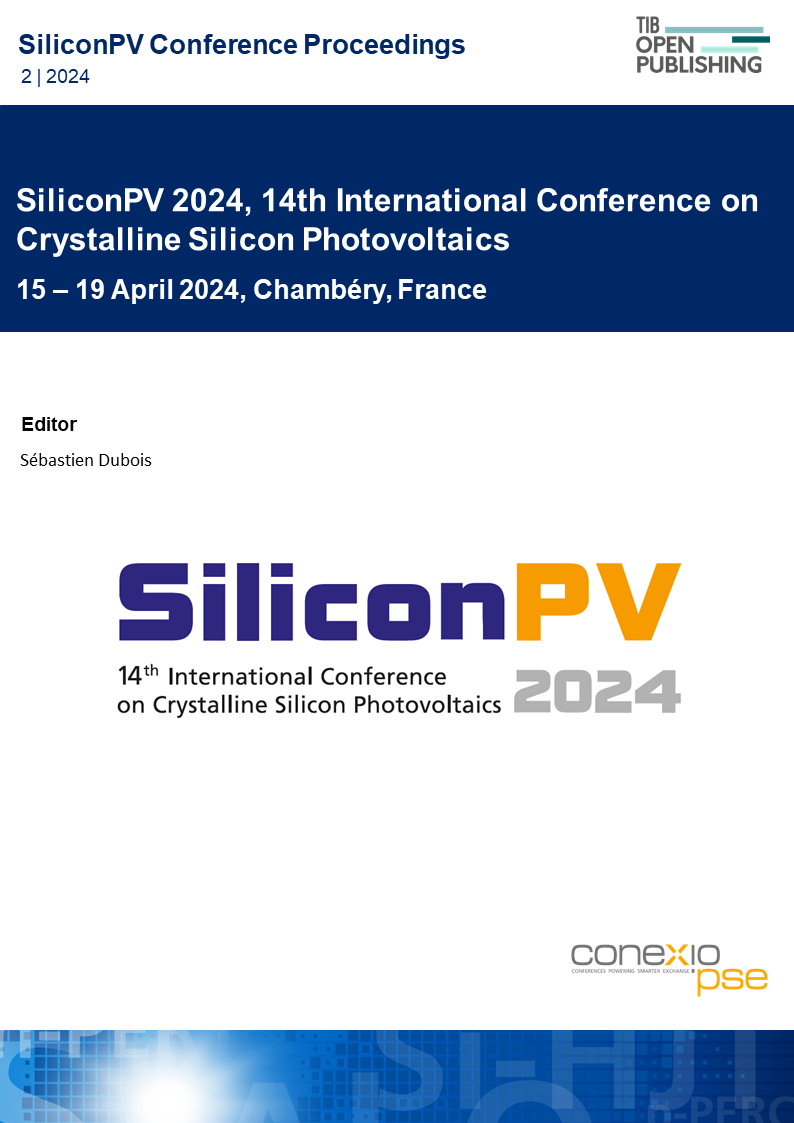Investigation of Contact Properties and Device Performance for Bifacial Double-Side Textured Silicon Solar Cells With Polysilicon Based Passivating Contacts
DOI:
https://doi.org/10.52825/siliconpv.v2i.1295Keywords:
Passivating Contacts, Polysilicon, MetallizationAbstract
We investigate the impact of the surface morphology on the contact properties of phosphorus doped poly-Si layers. If the poly-Si layer on a textured surface remains intact after high-temperature metallization using a fire-through (FT) silver (Ag) paste, the J0,metal is not expected to increase significantly while the specific contact resistivity can improve with a textured surface. The contact properties of the FT Ag contacts to n+ poly-Si deposited on both textured and planar surfaces are investigated by measuring and evaluating ρc and J0,metal. The reasons for differences in contact resistance and recombination are further investigated with SEM imaging. Solar cells with n-type polysilicon based passivating contacts on the rear side are fabricated and characterized. The scientific approach used, and the insights presented in this work, help to understand the mechanisms and behavior of screen-printed and fired-through contacts to polysilicon layers deposited onto textured silicon surfaces.
Downloads
References
Nandakumar, N., et al., Approaching 23% with large‐area monoPoly cells using screen‐printed and fired rear passivating contacts fabricated by inline PECVD. Progress in Photovoltaics: Research and Applications, 2019. 27(2): p. 107-112.
Mertens, V., et al., Plasma enhanced chemical vapor‐deposited SiOx (Ny)/n‐type polysilicon on oxide passivating contacts in industrial back‐contacted Si solar cells. Solar RRL.
Padhamnath, P., et al., Progress with passivation and screen-printed metallization of Boron-doped monoPoly™ layers. Solar Energy, 2022. 231: p. 8-26.
Padhamnath, P., et al., High-quality doped polycrystalline silicon using low-pressure chemical vapor deposition (LPCVD). Energy Procedia, 2018. 150: p. 9-14.
Reiter, S., et al., Parasitic absorption in polycrystalline Si-layers for carrier-selective front junctions. Energy Procedia, 2016. 92: p. 199-204.
Padhamnath, P., et al., Optoelectrical properties of high-performance low-pressure chemical vapor deposited phosphorus-doped polysilicon layers for passivating contact solar cells. Thin Solid Films, 2020. 699: p. 137886.
Padhamnath, P., et al., Development of thin polysilicon layers for application in monoPoly™ cells with screen-printed and fired metallization. Solar Energy Materials and Solar Cells, 2020. 207: p. 110358.
Nandakumar, N., et al., Large‐area monoPoly solar cells on 110 μm thin c–Si wafers with a rear n+ poly‐Si/SiOx stack deposited by inline plasma‐enhanced chemical vapour deposition. Progress in Photovoltaics: Research and Applications, 2023. 31(4): p. 360-368.
Padhamnath, P., et al., Design, development and analysis of large-area industrial silicon solar cells featuring a full area polysilicon based passivating contact on the rear and selective passivating contacts on the front. Solar Energy Materials and Solar Cells, 2023. 256: p. 112351.
Zhong, R., et al., Detailed investigation of electrical and optical properties of textured n-type and roughened p-type tunnel oxide passivated contacts for screen-printed double-side passivated contact silicon solar cell application. Thin Solid Films, 2023. 783: p. 140046.
Padhamnath, P., et al., Design and development of front and back contact solar cells with selective poly-Si passivating contact on the front and local Al contact on the rear. Solar Energy Materials and Solar Cells, 2024. 269: p. 112759.
Padhamnath, P., et al., Characterization of screen printed and fire-through contacts on LPCVD based passivating contacts in monoPoly™ solar cells. Solar Energy, 2020. 202: p. 73-79.
Padhamnath, P., et al., Metal contact recombination in monoPoly™ solar cells with screen-printed & fire-through contacts. Solar Energy Materials and Solar Cells, 2019. 192: p. 109-116.
PRADEEP, P., et al., Impact of firing temperature on fire-through metal contacts to P-doped (n) and B-doped (p) poly-Si. 2021.
Padhamnath, P., et al. Modeling of contact resistivity of fire-through Ag-Al contacts to boron doped LPCVD polysilicon layers. in AIP Conference Proceedings. 2022. AIP Publishing.
Glatthaar, R., et al., Contact Formation of Silver Paste and Atmospheric Pressure Chemical Vapor Deposition (n) Poly‐Silicon Passivating Contacts on Planar and Textured Surfaces. physica status solidi (a), 2022. 219(24): p. 2200501.
Chaudhary, A., et al., Influence of silicon substrate surface finish on the screen‐printed silver metallization of polysilicon‐based passivating contacts. physica status solidi (a), 2022. 219(9): p. 2100869.
Guo, C., et al., Influence of backside surface morphology on passivation and contact characteristics of TOPCON solar cells. Solar Energy, 2023. 258: p. 278-288.
Choi, C.-J., et al. Two-dimensional dopant profiling in POCl 3-diffused n+ emitter of textured silicon solar cells. in 2011 37th IEEE Photovoltaic Specialists Conference. 2011. IEEE.
Cabrera, E., et al., Current transport in thick film Ag metallization: Direct contacts at Silicon pyramid tips? Energy Procedia, 2011. 8: p. 540-545.
Fell, A. and P.P. Altermatt, A detailed full-cell model of a 2018 commercial PERC solar cell in Quokka3. IEEE Journal of photovoltaics, 2018. 8(6): p. 1443-1448.
Published
How to Cite
Conference Proceedings Volume
Section
License
Copyright (c) 2024 Pradeep Padhamnath, John Derek D. Arcebal, Sagnik Dasgupta, Gabby De Luna, Ajeet Rohatgi, Armin G. Aberle

This work is licensed under a Creative Commons Attribution 4.0 International License.
Accepted 2024-08-09
Published 2025-01-24
Funding data
-
U.S. Department of Energy
Grant numbers DE-EE0009350 -
Office of Energy Efficiency and Renewable Energy
Grant numbers DE-EE0009350
